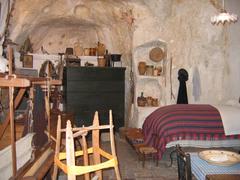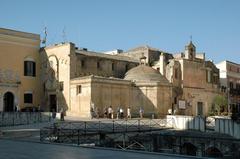National Museum of Matera: Visiting Hours, Tickets, and Historical Sites Guide
Date: 04/07/2025
Introduction
The National Museum of Matera is a cultural cornerstone set within one of the world’s oldest continuously inhabited cities. Celebrated for its ancient cave dwellings, or Sassi, Matera has undergone a remarkable transformation from a marginalized city to a UNESCO World Heritage Site and 2019 European Capital of Culture. The museum, comprising the Domenico Ridola National Archaeological Museum and the National Museum of Medieval and Modern Art at Palazzo Lanfranchi, preserves and presents Matera’s rich archaeological, artistic, and social heritage. This guide provides all the essential information for planning a visit—covering hours, tickets, must-see exhibits, accessibility, and nearby attractions—so you can fully experience Matera’s unique history and vibrant present. For further details and updates, consult the official museum website and resources like Matera Welcome and sassidimatera.net.
Table of Contents
- Introduction
- Historical Overview of the National Museum of Matera
- Matera’s Archaeological and Cultural Heritage
- Must-See Exhibits
- Permanent Collections
- Temporary Exhibitions and Special Events
- Visitor Information: Hours, Tickets, Accessibility
- Guided Tours and Educational Programs
- Amenities and Travel Tips
- Nearby Attractions
- Photography Policy
- Frequently Asked Questions (FAQ)
- Sustainable Development and Cultural Renaissance
- Conclusion and Call to Action
- Sources
Historical Overview of the National Museum of Matera
Foundation and Development
Founded in 1911, the National Museum of Matera owes its origins to Domenico Ridola, a physician and early archaeologist whose discoveries—beginning with the “Grotta dei Pipistrelli” in 1872—pioneered systematic exploration of the region (Matera Welcome). Over time, the museum’s collections expanded through significant acquisitions, such as the Rizzon collection of rare mask kraters in 1990. Today, the museum encompasses a vast array of artifacts, from prehistory to the modern era, and bridges Matera’s ancient legacy with its contemporary cultural revival.
Matera’s Archaeological and Cultural Heritage
Matera stands as one of the world’s oldest continuously inhabited cities, with evidence of human settlement stretching back over 9,000 years (Tourist Secrets). The Sassi districts—Sasso Barisano and Sasso Caveoso—are iconic for their labyrinthine cave dwellings, rock-hewn churches, and communal spaces (The Road Reel). Matera’s strategic location fostered cultural exchanges, blending Roman, Byzantine, and Norman influences (Italy Chronicles).
By the mid-20th century, social decline led to the Sassi’s abandonment and Matera’s branding as Italy’s “national shame” (Continuous Roamer). However, heritage conservation efforts and UNESCO recognition in 1993 sparked a renaissance, transforming Matera into a model for sustainable cultural tourism and urban regeneration (Academia.edu).
Must-See Exhibits
Prehistoric and Ancient Artifacts
- Serra d’Alto Pottery: Distinctive ceramics from the 5th millennium BCE, exemplifying early agricultural society (Matera Welcome).
- The Rizzon Collection: Rare mask kraters used in ancient funerary rituals, revealing mythological and ceremonial traditions.
- Princely Tombs and Warrior Graves: Burial goods, weapons, and jewelry from Iron Age tombs provide insight into early social structures.
Roman and Medieval Exhibits
- Coins, Inscriptions, and Everyday Objects: Illustrate Matera’s integration within the wider Mediterranean.
- Rock-Hewn Churches: The museum connects to Matera’s network of over 150 rock-cut churches adorned with Byzantine frescoes (Tourist Secrets).
Modern and Contemporary Art
- Works by Carlo Levi: Paintings and writings by Levi, whose memoir “Christ Stopped at Eboli” brought attention to Matera’s plight (pugliaguys.com).
- Contemporary Installations: Modern artworks, multimedia, and photography connect Matera’s past with its future (sassidimatera.net).
Permanent Collections
Archaeological Holdings
- Neolithic to Roman: Tools, pottery, jewelry, and everyday objects from local excavations (sassidimatera.net).
- Unique Fossils: The whale fossil “Giuliana” is a highlight for visitors and educational programs.
Medieval and Modern Art
- Religious Art: Paintings, sculptures, and liturgical objects from the city’s churches, monasteries, and local masters (sassidimatera.net).
- Regional Artists: Works by Basilicata and southern Italian artists, reflecting Mediterranean influences.
20th-Century and Contemporary Art
- Paintings, Sculptures, Photographs: Created by local and national artists, showing Matera’s evolving identity.
- Popular Culture: Exhibits feature traditional costumes, musical instruments, and everyday objects.
Temporary Exhibitions and Special Events
The museum regularly hosts thematic archaeological exhibitions, contemporary art installations, and cultural festivals—often in collaboration with national and international institutions (finestresullarte.info). Highlights include retrospectives on Italian Futurism, cinema-themed exhibits, and partnerships with the Uffizi Gallery.
Visitor Information: Hours, Tickets, Accessibility
Visiting Hours
- Standard Hours: Tuesday to Sunday, 9:00 AM to 7:00 PM. Last admission 30 minutes before closing; closed Mondays and certain holidays. Confirm seasonal variations on the official website.
Tickets
- Admission: €5.00 for the Ridola Museum, €3.00 for Palazzo Lanfranchi (as of July 2025). Discounts for students, seniors, and children; combined tickets available.
- Purchase: Buy onsite or online to skip queues (sassidimatera.net).
Accessibility
- Facilities: Ramps and elevators where feasible; some areas may be challenging due to historic architecture.
- Audio Guides: Available for major exhibits; multilingual signage provided.
- Contact: Visitors with specific needs should contact the museum in advance.
Guided Tours and Educational Programs
- Guided Tours: Offered in several languages; thematic tours for groups, schools, and families. The whale fossil “Giuliana” tour is especially popular.
- Workshops & Events: Educational workshops, lectures, and hands-on activities are scheduled regularly, especially during festivals.
Amenities and Travel Tips
- Facilities: Restrooms, cloakrooms, and a bookshop/gift shop.
- Food: No large cafés inside, but many options nearby in the historic center.
- Location: Both museums are centrally situated—Ridola Museum in the Sassi district, Palazzo Lanfranchi at Piazzetta Pascoli.
- Transport: Reachable by foot from main squares; parking is limited, so public transport or walking is advised.
Nearby Attractions
- Casa Noha: Multimedia museum on Matera’s history.
- Rock-Hewn Churches: Explore the UNESCO-listed churches carved into the rock.
- Historic Sassi District: Wander the cave dwellings and narrow streets.
- Matera Cathedral and MUSMA: Additional highlights within walking distance (Matera Sassi e Murgia).
Photography Policy
Non-flash photography is generally permitted, but restrictions may apply in some galleries or temporary exhibitions. Respect posted signage and staff instructions.
Frequently Asked Questions (FAQ)
Q: What are the museum’s visiting hours?
A: Tuesday to Sunday, 9:00 AM to 7:00 PM; closed Mondays. Check the official website for updates.
Q: How much are tickets?
A: Standard tickets are €5.00 (Ridola) and €3.00 (Lanfranchi), with discounts and combined options.
Q: Is the museum accessible?
A: Accessibility is improved but some historic areas may present challenges. Contact the museum in advance for assistance.
Q: Are guided tours available?
A: Yes, in multiple languages, with specialized thematic tours.
Q: Can I take photos?
A: Non-flash photography is generally permitted except where indicated.
Sustainable Development and Matera’s Cultural Renaissance
The National Museum of Matera is a leader in sustainable cultural tourism and urban regeneration. Its educational outreach, community engagement, and innovative exhibitions foster civic pride and global recognition (Academia.edu). By balancing preservation with creative innovation, the museum ensures Matera’s legacy remains vibrant and relevant.
Conclusion and Call to Action
The National Museum of Matera offers an immersive journey through thousands of years of history, bridging ancient civilizations with modern cultural innovation. Whether you are a history buff, art enthusiast, or traveler seeking authentic experiences, this museum is a must-visit destination in southern Italy. For the most enriching visit, check opening hours and ticket options online, and consider combining your museum experience with a tour of Matera’s storied Sassi, churches, and vibrant city center.
Download the Audiala app for interactive guides, updates, and exclusive content. Follow museum and city social media channels for news on exhibitions and events. Begin your exploration of Matera—a city where the past and present converge in extraordinary ways.
Sources
- Tourist Secrets
- Matera Welcome
- sassidimatera.net
- Matera Welcome - Palazzo Lanfranchi
- The Road Reel
- Italy Chronicles
- Continuous Roamer
- Anna Everywhere
- Small But Gold
- pugliaguys.com
- finestresullarte.info
- WhichMuseum
- Matera Sassi e Murgia


